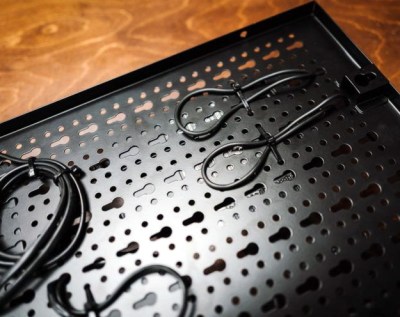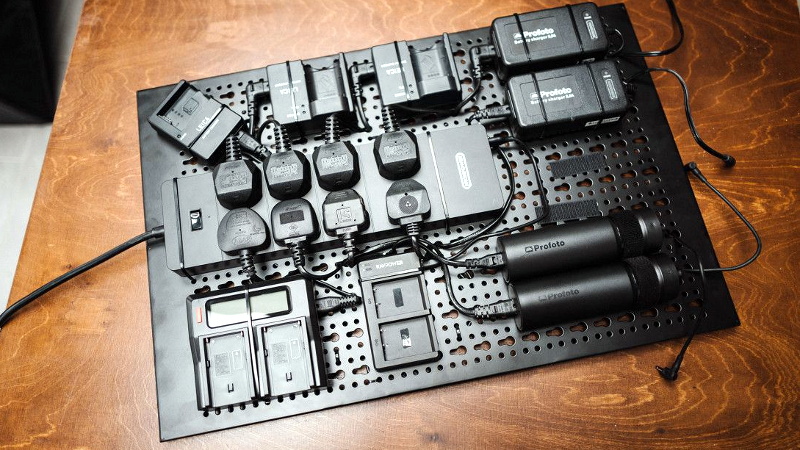Do you have a bunch of electronic devices that all have different styles of chargers and batteries? Of course you do, so does everyone else. While there’s been some headway made towards standardizing on USB (and more recently, USB-C) for charging, there are still plenty of gadgets out there that march to the beat of their own DC adapter. For all those devices, [Tom Barnes] has a tip for making a cheap and easy centralized charging station.
 The idea is to get a power strip, ideally one that has a switch on it, and use zip ties to attach it to a piece of pegboard. [Tom] used a nice black steel board which is obviously very strong and shouldn’t be bothered by any potentially high temperatures, but you could get away with the hardware store MDF variety if you had to.
The idea is to get a power strip, ideally one that has a switch on it, and use zip ties to attach it to a piece of pegboard. [Tom] used a nice black steel board which is obviously very strong and shouldn’t be bothered by any potentially high temperatures, but you could get away with the hardware store MDF variety if you had to.
All your chargers, mounted around the periphery of the board with Velcro hook and loop fasteners, have their individual power cords run through to the back of the board where they are nearly routed and zip tied. This is where using the steel pegboard really helped, as it has a lip around the edge that makes a void for all the wires to be run through when hung on the wall. If your particular flavor of pegboard doesn’t have that space behind it, you’d either have to settle for running the wires across the front or build out your own space in the back using a wooden frame.
Even in our high-tech world, no shop is truly complete without pegboard. Whether you’re using it to vertically mount your development boards, or pushing it around on wheels to keep your tools close at hand, there’s no shortage of ways to use this versatile material.















I never submited anything to hackaday because I felt my projects wouldn’t be good enough. Now I am not so sure anymore… hmm.
That’s basically the same as saying “Voting doesn’t change anything, my vote won’t count, so I will not”
And look at the state of the world now. Just submit your projects, and stop underestimating yourself :)
Do your project for yourself and don’t try to please the crowd at HaD. You’ll be happier that way.
Unless you are trying to cash in the popularity.
Since you seem to be the kind of person who belittles the ideas of others, I’m willing to bet your projects still aren’t good enough.
You might be correct. It is however unfortunate that any discussion regarding the presented information (article) must devolve into personal insults. I would have hoped to simply draw attention to the question at hand; Is zip tying a hack?
I would like to start out by saying that this question has no influence on the success and usefulness of this particular project. If it works, then it is a success IMHO, and sharing a personal success should be a rewarding experience. What I am wondering is where the line is between hacks and simply “doing a project”. If I were to use bolts to attatch something to peg board, would this also be considered a hack? Personally I am not sure. Again, this is just my opinion and not any more valid than yours. (In this day and age it is important to always announce that fact, lest some might think I am trying to overrule their natural right to form thoughts and concluisions for themselves.) Maybe this website is more about projects than hacks nowdays. That wouldn’t stop me from visiting and enjoying what I read about – but it might influence my comments. :D
It’s in a very different category than someone doing SDR witchcraft by reverse engineering some conveniently now-cheap device that happens to be based on a surprisingly powerful FPGA or something; but why the disdain for a simple, logical, aesthetically pleasing, readily customizable, project that attacks a problem many of us have in a way that makes a work or living space less cluttered, more pleasant, and less likely to suffer from devices and chargers disappearing into the cable nest right when we need them?
I have the greatest respect for hardcore technical virtuosity; but pleasing, practical, solutions to irritating problems are a perfectly valid genre of hack; and often a particularly handy one to see examples of to improve one’s own setup.
I’d freely admit that the hypothetical FPGA badass is more hardcore, and I will enjoy reading about his project; I’d also freely admit that this project is vastly more likely to reduce the cable clutter I have to deal with in the relatively near future, and that seems like a win to me.
Instead of being pedantic about what projects are posted here just based on the website name, why not look at the name on a different angle? Disregard the “hack” in hackaday and just read the articles for what it is.
Also, yes, this is considered a “hack” in my book just because a couple of objects was put together in a way that it wasn’t meant to be as shallow and simple as it may be. Content here will only be as good as what the community has published online.
Slow news day perhaps? Using a pegboard for it’s intended purpose is newsworthy nowadays?
Its not hackaday unless someone declares something not a hack.
It should have a 8ch wifi/bluetooth controlled distribution strip or a at least a single channel to turn the whole mess on/off. Custom user interface on cellphone would be nice too. Maybe some optos to determine when charging is done on certain ports to feedback to ‘smart device’ with appropriate action. Theres no 555, ESP, Pi, Arduino, or
some overly elaborate mechanical device/mechanism. So as to being a hack –meh. All those chargers should be piled haphazardly on top of workspace like a proper hacker. Sure it looks better and is neatly done but minus points for not being a rats nest of tangled spaghetti like a locked 3D printer mis step.
great idea
Nice. I could possibly use this idea. Grabbed some pegboard sets from a dollar store a few months back. Not sure they have them as a continuing line, it was one of those things that looks way too good/useful to be dollar store cheap for long, so you buy some if you have spare cash. Anyway, the buying while available happened and I didn’t have a specific use for them yet. I rack or shelve most of my work area wall space, so I was wondering if they’d go inside or outside closet doors or something.
So applying to my wallwart/power adapter mess might happen on the “privacy panels” of desks, instead of having them all hanging around behind the monitor in a powerstrip or kicking around like scary grapes off an extension on the floor. Could have everything more organised hiding under there. Just wondering if it would be more or less of a PITA every time I needed to change something or move a piece of hardware temporarily though. Guess I’d just have to be careful what I put down with zipties and what I used refastenable stuff for…. though really I don’t know why I can’t get over using zipties more disposably, considering they cost very little now.
The neater your cable tidying the greater the effort any change will be, i myself oscillate between superb cable management and vague control over the electric snake farm.. Usually go in for tidy, but that takes time and energy. When you don’t have enough of either do what you can and hope out of sight is out of mind enough.
For something like this cable ties need not be used if you have some ingenuity and time to spare – 3d printed or bent metal clips could be used for example. Don’t want to get into the habit of throwing away really useful zipties just because they are cheap, by all means use them and don’t be overly concerned if their lifespan works out to be rather short. Plan to be efficient with what you use so you can feel good about it, but never let worry about wasting a few materials put you off a good idea.
I know I’m cheap, but I still use a fingernail, tiny screwdriver, pick or knife to pull back the latch and re-use zip-ties
Not cheap but environmentally considerate. Some of my ties have an extra tag that’s supposed to make re-using them easier but doesn’t seem to much.
When you buy a new bit of electrical equipment, don’t just throw the twist tags in the bin, throw them in a drawer, and re-use them in future.
They don’t last forever, but they’re a lot easier to re-use.
A friend has a novel idea for the kitchen rats nest of charging tablets and phones and keeping track of their separate chargers. On the wall is a panel of solid wood that has along side a power strip a series of wooden pockets sized to fit devices with the front cut way down (2 rails on each side better) giving clear view of the screen are set out in a row. You can pull up and out any device and then disconnect it’s cable and leave it hanging out of the empty pocket which has a recess and hole in the bottom. They all have bottom charging ports.
Returning is easy as each pocket can be labeled at the back and has the right cable ready for it’s own device.This whole rack can be at eye level and usable for reading notifications and weather. No countertop weather splashes or spills to get into those USB micro ports on your phone.
I actually find myself mystified by the amount of people that charge phones and tablets in the kitchen. Always teetering on a coffee maker or something at risk of been knocked in the sink or put down on a spill on the counter. Ideal environment for spendy electronics it ain’t.
WHERE can I get THAT pegboard, please? All the ones on Amazon have either round holes, and/or slots, but none have the tapered teardrop holes like this…
^^ Meant to say: the link to Amazon returns an Amazon Error.
I did manage to find a page for it, but it’s “Currently Unavailable”.
https://www.amazon.com/VonHaus-Piece-Mounted-Metal-Pegboard/dp/B07HQP3RGR
B075CDZ2RL looks similar.
No ground connecgtion on the steel pegboard? For shame…
How many times have you grabbed a charging cable to be shocked by its ground shield?
I’m honestly not sure I’ve ever been shocked by a charging cable. Are you sure it wasn’t you who shocked the cable? Do you wear a lot of synthetic fibres and rubber shoes?
If you’re getting shocked by the ground shield you’ve got problems external to your wiring tidying.
Zip tying is not a hack. Neither is attaching stuff using hook and loop fabric, rivets, glue or bolts. But the fasteners used are irrelevant.
Attaching chargers, battery holders and power distribution to a pegboard and hiding the wiring mess behind it, IS a good idea. And good ideas are worth sharing. If the solution/project/hack is obvious to someone, good for them. It wasn’t obvious to me, and I am grateful that someone shared their good idea.
On another note, the slightly paranoid electrician in me would have grounded the pegboard for protection even though the mains stuff on is is supposed to be double insulated.